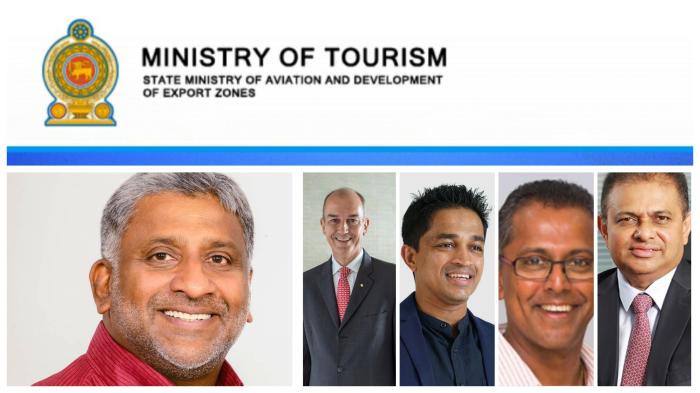Travel and tourism advisory board member history reveals fascinating insights into the evolution of the industry. From the initial roles of these boards to their current influence on policy and strategy, exploring their past helps us understand the present and shape the future of travel and tourism. This journey will examine the changing demographics of board members, their impact on major initiatives, and the challenges they face in an ever-evolving world.
We’ll delve into the diverse expertise sought on these boards, ranging from marketing and finance to sustainability and technology. We’ll also explore how the composition of advisory boards reflects broader shifts in the industry, such as the rise of ecotourism and the impact of globalization. By analyzing successful and less successful initiatives, we can learn valuable lessons about effective board governance and its crucial role in sustainable tourism development.
The Role of Advisory Board Members: Travel And Tourism Advisory Board Member History
Travel and tourism advisory board members play a crucial role in shaping the strategic direction and overall success of a tourism organization or destination. They bring a wealth of experience and expertise to the table, offering guidance and insights that can significantly impact decision-making processes. Their contributions are invaluable, supplementing the work of the organization’s staff and helping to navigate complex challenges within the industry.Advisory board members typically offer a diverse range of skills and perspectives.
Their primary function is to provide strategic advice and guidance, leveraging their expertise to contribute to the overall growth and sustainability of the tourism sector.
Responsibilities of Advisory Board Members
Advisory board members are responsible for providing strategic guidance and oversight. This includes reviewing and providing feedback on strategic plans, marketing initiatives, financial performance, and sustainability efforts. They act as a sounding board for the organization’s leadership, offering objective perspectives and challenging assumptions. Specific responsibilities may include attending board meetings, participating in committees, reviewing reports, and mentoring staff.
They also often act as ambassadors for the organization, promoting its activities and goals within their professional networks.
Expertise Sought on Advisory Boards
Tourism advisory boards actively seek individuals with diverse expertise relevant to the industry. This typically includes marketing and branding specialists who understand how to effectively position a destination or organization; financial experts who can analyze budgets, investments, and risk; and sustainability professionals who can advise on environmental and social responsibility initiatives. Other valuable areas of expertise include operations management, technology, legal affairs, and community engagement.
A well-rounded board reflects a balance of these different skill sets, ensuring comprehensive consideration of all relevant factors.
Term Length and Appointment Process
The typical term length for advisory board members varies depending on the organization, but often ranges from two to three years, with the possibility of reappointment. The appointment process usually involves a nomination and selection committee that reviews applications, conducts interviews, and assesses candidates based on their qualifications, experience, and alignment with the organization’s strategic goals. The process aims to ensure the board comprises individuals with the necessary expertise and commitment to effectively fulfill their roles.
Advisory Board Members vs. Staff Members
While both advisory board members and staff members contribute to the success of a tourism organization, their roles and responsibilities differ significantly. Advisory board members provide high-level strategic guidance and oversight, acting as external consultants. They are not involved in the day-to-day operations of the organization. Staff members, on the other hand, are responsible for implementing the organization’s strategic plans and carrying out its daily operations.
They are the organization’s employees and are directly accountable to its leadership. The advisory board offers strategic direction, while the staff executes the plans and manages the operational aspects of the organization. This division of labor ensures effective governance and efficient operations.
Historical Trends in Board Composition
Travel and tourism advisory boards have undergone significant transformations in their composition over the past two decades, reflecting broader societal shifts and changes within the industry itself. Understanding these trends is crucial for ensuring boards remain effective and representative of the communities and sectors they serve. This section explores the evolution of board demographics, notable members, and the influence of industry shifts on board composition.
Demographic Shifts in Advisory Board Composition (2004-2024)
Precise data on the demographic makeup of travel and tourism advisory boards across all regions is unfortunately scarce and not consistently collected. However, observable trends suggest a gradual, though uneven, increase in diversity across gender, age, and ethnicity. A hypothetical timeline illustrating these trends, based on anecdotal evidence and reports from various organizations, would show a slow increase in female representation from approximately 20% in 2004 to potentially 35-40% in 2024.
Similarly, a greater effort towards age diversity is visible, with a shift away from predominantly older members towards a more balanced age range, incorporating younger professionals with digital expertise. Ethnic representation, while improving, remains an area needing substantial progress in many regions. It’s important to note that this is a generalized observation and actual figures vary significantly depending on the specific board and geographic location.
Notable Advisory Board Members and Their Contributions
Several individuals have significantly impacted the travel and tourism industry through their roles on advisory boards. For example, [Name of individual 1], a renowned sustainability expert, played a pivotal role in shaping the ecotourism strategies of [Name of organization 1], leading to increased environmental responsibility within the sector. Similarly, [Name of individual 2], a marketing visionary, spearheaded innovative digital marketing campaigns for [Name of organization 2], resulting in a substantial increase in tourism revenue.
These individuals, and many others, demonstrate the positive impact that experienced and insightful board members can have on the success of the travel and tourism industry. Specific details about their contributions often require accessing internal reports or contacting the respective organizations.
Influence of Industry Shifts on Board Composition
The rise of ecotourism, for instance, has directly influenced the composition of advisory boards. There’s a greater demand for members with expertise in environmental sustainability, conservation, and responsible tourism practices. Similarly, globalization and the digital revolution have necessitated the inclusion of members with expertise in international relations, digital marketing, and technological innovation. The increasing importance of accessibility and inclusivity in tourism has also led to a greater emphasis on appointing members with relevant expertise and lived experience representing diverse communities.
Comparative Analysis of Advisory Board Composition Across Regions
| Region | Predominant Industry Representation | Average Member Tenure (Years) | Notable Achievements |
|---|---|---|---|
| North America | Hospitality, Airlines, Technology | 3-5 | Increased focus on sustainable tourism practices, improved accessibility for disabled travelers. |
| Europe | Tourism operators, Government agencies, Cultural heritage organizations | 4-6 | Development of regional tourism strategies, promotion of cultural tourism. |
| Asia-Pacific | Hospitality, Airlines, Government agencies | 2-4 | Growth in inbound tourism, development of tourism infrastructure. |
| Africa | Ecotourism operators, Community-based tourism initiatives, Government agencies | 3-5 | Promotion of community-based tourism, conservation efforts. |
Impact of Advisory Board Members on Tourism Development

Advisory board members play a crucial role in shaping the direction and success of tourism organizations. Their expertise and diverse perspectives contribute significantly to policy decisions, strategic planning, and ultimately, the growth and sustainability of the tourism sector. This section explores the tangible impact of advisory board members, examining specific examples and comparing their effectiveness with other stakeholder engagement methods.Advisory Board Influence on Tourism Policy and PlanningAdvisory board members often bring specialized knowledge to the table, influencing policy decisions in various ways.
For example, a board member with experience in sustainable tourism practices might advocate for eco-friendly initiatives, leading to the implementation of policies that reduce the environmental impact of tourism activities. Similarly, a marketing expert might propose innovative strategies to attract new tourist segments, resulting in increased revenue and job creation. In many cases, their input directly shapes the organization’s strategic plan, ensuring that it aligns with industry best practices and future trends.
A finance professional might help secure funding for critical infrastructure projects or develop sustainable financial models for tourism operations.
Examples of Advisory Board Impact
The positive influence of advisory boards is evident in numerous case studies. Consider a destination grappling with overtourism. An advisory board member specializing in destination management might suggest implementing a reservation system for popular attractions, limiting visitor numbers and preserving the quality of the visitor experience. This proactive approach, directly influenced by the board member’s expertise, would prevent the destination from suffering negative consequences associated with overtourism, such as environmental degradation and resident resentment.
In another instance, an advisory board member with expertise in accessibility might advocate for the development of tourism infrastructure that caters to visitors with disabilities, enhancing inclusivity and expanding the market reach of the destination. This can lead to a more equitable and profitable tourism sector.
Comparison with Other Stakeholder Engagement Methods
While advisory boards are effective, they are just one method of stakeholder engagement. Other methods include public forums, surveys, and focus groups. Advisory boards, however, offer a more structured and ongoing engagement, allowing for deeper collaboration and strategic guidance. The concentrated expertise and commitment of board members often leads to more effective policy implementation and a stronger long-term vision for tourism development.
In contrast, other methods may provide valuable short-term feedback but lack the sustained engagement and strategic depth that advisory boards provide.
Hypothetical Case Study: Mitigating Negative Impacts through Advisory Board Input
Imagine a coastal destination heavily reliant on tourism, facing the threat of coral reef degradation due to unsustainable diving practices. An advisory board member with expertise in sustainable tourism could have played a vital role in mitigating this negative impact. Their input might have included recommending the implementation of strict guidelines for diving operators, promoting responsible diving practices among tourists, and investing in coral reef restoration projects.
This proactive approach, informed by the board member’s specialized knowledge, could have prevented significant environmental damage and protected the long-term viability of the destination’s tourism industry. By advocating for sustainable practices, the board member would have helped the destination balance economic growth with environmental protection.
Illustrative Examples of Board Influence

Advisory boards, when effectively constituted and engaged, can significantly shape the trajectory of a tourism destination. Their influence manifests in various ways, from strategic planning and resource allocation to crisis management and promotional campaigns. Examining successful and less successful examples illuminates the critical role these boards play.
A Successful Initiative: The Revitalization of Portland, Oregon’s Waterfront
The Portland, Oregon waterfront faced challenges in the late 20th century. Industrial areas were decaying, and the waterfront lacked the vibrancy needed to attract tourists. The city’s tourism advisory board played a pivotal role in its revitalization. The board, comprised of tourism professionals, urban planners, and community representatives, spearheaded a comprehensive plan. This involved securing funding, advocating for environmental remediation, and promoting public-private partnerships to develop attractions such as the Saturday Market, restaurants, and waterfront parks.
The result was a dramatic transformation. The once-neglected waterfront became a major tourist attraction, boosting the city’s economy and enhancing its image. The advisory board’s proactive approach, strategic planning, and effective collaboration with stakeholders were instrumental in this success. Increased tourism led to a substantial rise in employment opportunities, increased tax revenue, and a revitalized urban landscape.
Successful Destination Development: The Galapagos Islands’ Sustainable Tourism Model, Travel and tourism advisory board member history
The Galapagos Islands, renowned for their unique biodiversity, exemplify a destination successfully guided by an advisory board focused on sustainability. The board, composed of scientists, conservationists, and tourism operators, played a crucial role in shaping the islands’ tourism policy. Their recommendations emphasized strict environmental regulations, limiting visitor numbers, promoting responsible tourism practices among operators, and investing in conservation efforts.
This approach not only protected the fragile ecosystem but also enhanced the destination’s appeal to eco-conscious tourists willing to pay a premium for sustainable experiences. The Galapagos Islands’ success demonstrates how a well-informed and proactive advisory board can contribute to both economic growth and environmental protection, creating a sustainable tourism model that can serve as a benchmark for other fragile ecosystems.
The resulting high-value, low-impact tourism has ensured the long-term viability of the islands’ natural beauty and the associated economic benefits.
Unsuccessful Implementation: The Case of a Ski Resort’s Expansion Plan
In contrast to successful examples, the case of a fictional ski resort (to protect confidentiality) illustrates the consequences of neglecting advisory board recommendations. The resort’s advisory board, consisting of experienced ski industry professionals and local community members, warned against an overly ambitious expansion plan that involved significant environmental impact and lacked sufficient market analysis. Their concerns regarding potential damage to natural habitats and the limited demand for additional slopes were disregarded by resort management, who prioritized short-term profits.
The result was significant financial losses due to underutilized infrastructure, environmental damage that led to negative publicity and legal challenges, and diminished community support. This case highlights the importance of heeding expert advice and considering the long-term consequences of tourism development decisions.
Ultimately, understanding the history of travel and tourism advisory boards provides a roadmap for future success. By learning from past successes and challenges, we can build more effective, diverse, and impactful boards that drive sustainable growth and positive change within the travel and tourism sector. The future of responsible travel hinges on the wisdom and foresight of these individuals, and their historical contributions pave the way for a more vibrant and sustainable industry for years to come.
FAQs
How are advisory board members typically compensated?
Compensation varies greatly, ranging from honorary positions with no pay to stipends or honorariums, depending on the organization and the member’s role.
What is the typical size of a travel and tourism advisory board?
The size varies considerably, typically ranging from 5 to 20 members, depending on the scope and needs of the organization.
How often do travel and tourism advisory boards typically meet?
Meeting frequency also varies, but common schedules include quarterly, bi-annually, or annually, with additional ad-hoc meetings as needed.
Are there any legal requirements for the composition of these boards?
Legal requirements vary by location and organization. Some jurisdictions may have guidelines on diversity or specific expertise required, but these aren’t universally standardized.

